Vegetable extracts
Origin and specifications of our vegetable extracts
| Oakbark | Gambier | Chestnut | Mimosa | Myrobalan | Quebracho | Sumac | Tara | Trillo / Valonea |
| Europe | China India Malaysia Indonesia | Europe (Central) (South) | Australia Brazil Africa (South/East) | India | Argentina Paraguay Brazil Bolivia | Europe (South) | South America Peru | Europe (Southeast) Asia (fewer) |
| Hydrolysable tanning materials (acidic former) | Pyrocatechin tanning material (Phlobaphen former) |
| Chestnut extract Myrobalan extract Sumac extract Tara Trillo & Valonea extract | Oakbark Gambier extract Mimosa extract Mimosa bark Quebrach extract |
| Specifications | Oakbark | Gambier extract | Chestnut standard |
Chestnut 'sweetened' | Mimosa extract | Mimosa bark |
| Tannin content in % | 6 - 17 | 50.0 +/- 2.0 | 75 - 77 | 72.0 +/- 0.2 | 72.5 (min.) | 33.9 |
| Insolubles in % | 71.0 | 12.0 | < 1.0 | 1.0 (max.) | 39.4 | |
| Humidity in % | 12.0 | < 8.0 | 7.0 (max.) | |||
| Non-tanning in % | Ø 5.5 | 17.0 | 18 - 22 | 26.5 (max.) | 11.9 | |
| Sugar in % | Ø 2.6 | 3.0 - 4.0 | ||||
| Ash in % | 4.5 | 5.0 | 3.5 (max.) | |||
| pH | 4.6 +/- 0.31 | 3.5 +/- 0.51 | 4.5 +/- 0.21 | 4.3 - 4.7 | ||
| Iron in ppm | 80 (max.) | |||||
| Solubles in % | 45.8 | |||||
| Specifications | Myrobalan | Quebracho | Sumac | Tara | Trillo | Valonea |
| Tannin content in % | 62 +/- 0.5 | 76 +/- 1.5 | 62.0 +/- 2.0 | > 50 | 29.0 - 40.0 | 65.0 |
| Insolubles in % | 2.0 +/- 0.5 | 0.3 +/- 0.1 | 5.0 | 2.5 | 8.0 - 13.0 | 1.5 |
| Humidity in % | 6.0 +/- 0.4 | 8.0 +/- 2.0 | 5.0 | < 10 | 7.0 | |
| Non-tanning in % | 28 +/- 0.5 | 15.0 +/- 1.5 | 30.0 | 21.3 | 33.0 - 47.0 | 24.5 |
| Sugar in % | 3.0 - 4.0 | |||||
| Ash in % | 3.0 | 6.5 max. | 4.5 | |||
| pH | 3.1 +/- 1.01 | 4.4 - 4.91 | 3.71 | 3 - 41 | 4.2 +/- 0.31 | 3.62 |
Packing depends on the product and the amount ordered.
Because of that you will receive packing information corresponding with your request for quotation.
Information in our product descriptions are not considered applicable in general. They have been assembled to the best of knowledge and do not constitute a guarantee or basis of liability.
Descriptions and applications of our vegetable extracts
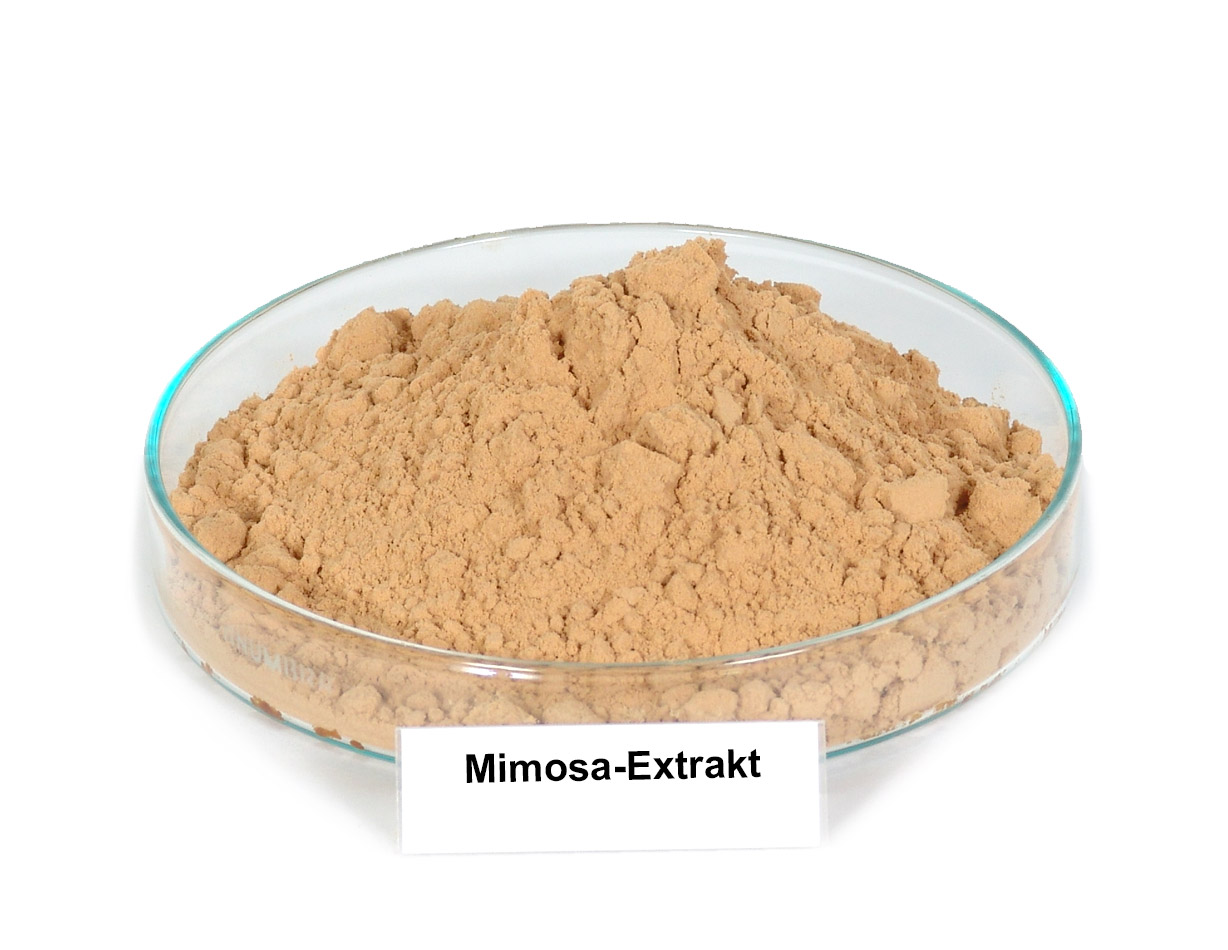
Mimosa extract
Botanical name: Acacia negra, Acacia molissima
Used for production of soles, straps, harnesses, cases, upholsteries and others
Colour: Red 4.1% / Yellow 6.2%
Description
The application of Mimosa is very common worldwide and it can be modified by mixing with other types of tanning materials to adopt its characteristics to the specific leather type in re-tanning. Properties are natural soluble extracts, uniform in quality, pale in colour, low in salts and sludge formation. Correct tanning conditions give rapid penetration followed by high tannin fixation. Particularly suitable for the re-tanning of chrome leather where fullness, buff ability and good printing and plating properties are required. The combination with other anionic tanning agents such as Suntans (Retanin SO), resins and polymers is common practice to enhance the finishing of the leather. In general, Mimosa is now the favourite natural tanning agent in the use of fast modern tanning systems in pits or drums. The light colour of our Mimosa produces light colour leather that camouflages grain defects and improves the selection of the finished leather and therefore results in higher quality of the leather.
Application
Ideal for the production of soles, straps, harnesses, cases, upholsteries, linings and other vegetable tanned leathers.
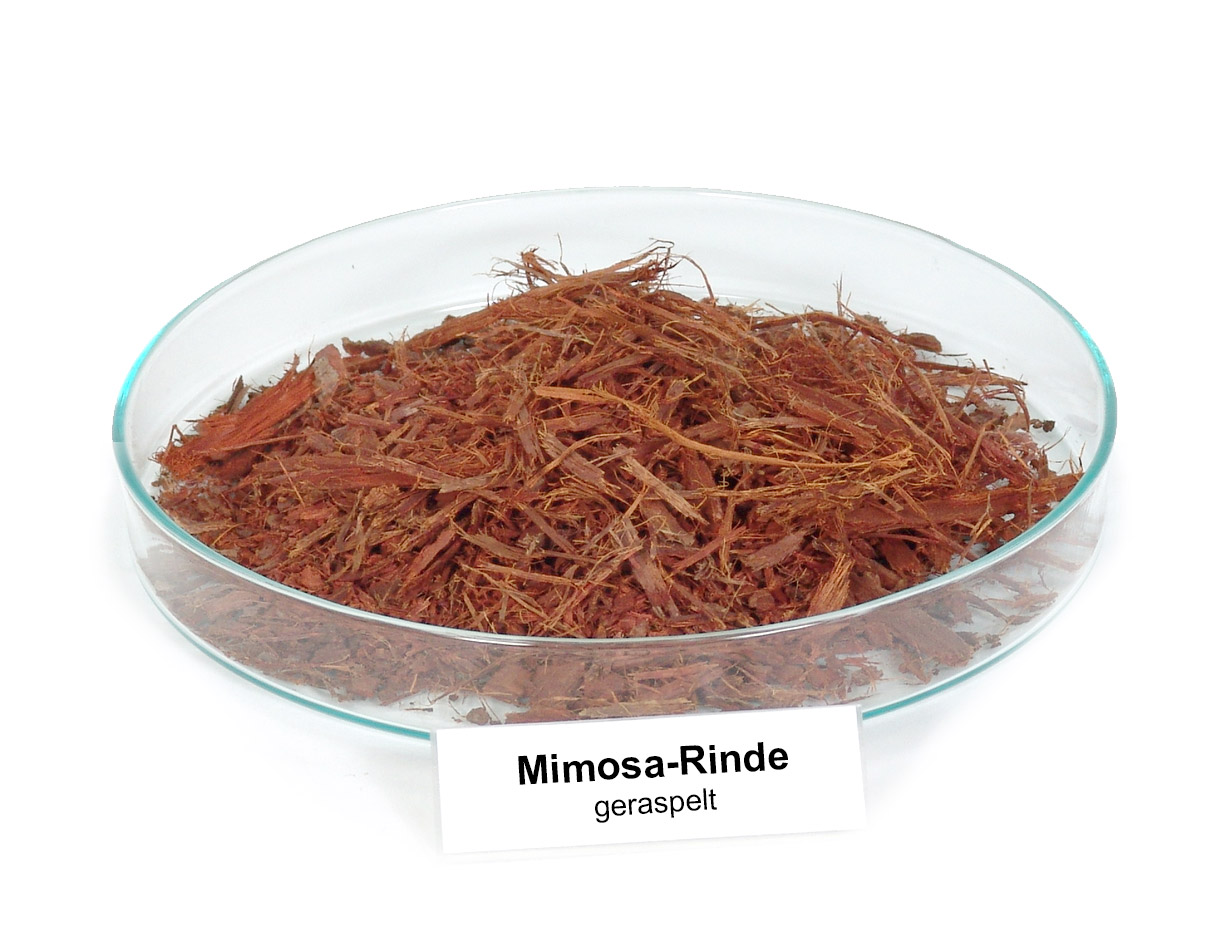
Mimosa bark
Botanical name: Acacia negra, Acacia molissima
Used for robust, light and slightly reddish leathers
Colour: Red 4.1% / Yellow 6.2%
Description
Only the barks of the trees are used and they are rasped after peeling. This tree is cultivated in tree nurseries and can be peeled 7 years after having been planted out. The rasped wood of the inner trunk is also used in the chipboard industry or for charcoal.
Application
Mimosa tanned leather provides a robust, light and slightly reddish leather, which is sensitive to light and darkens gradually. Today it is used in tanning in combination with oak bark especially for sole leather in the higher price segment and for sanitary shoes. Due to the long production time of this leather the production costs are quite high.
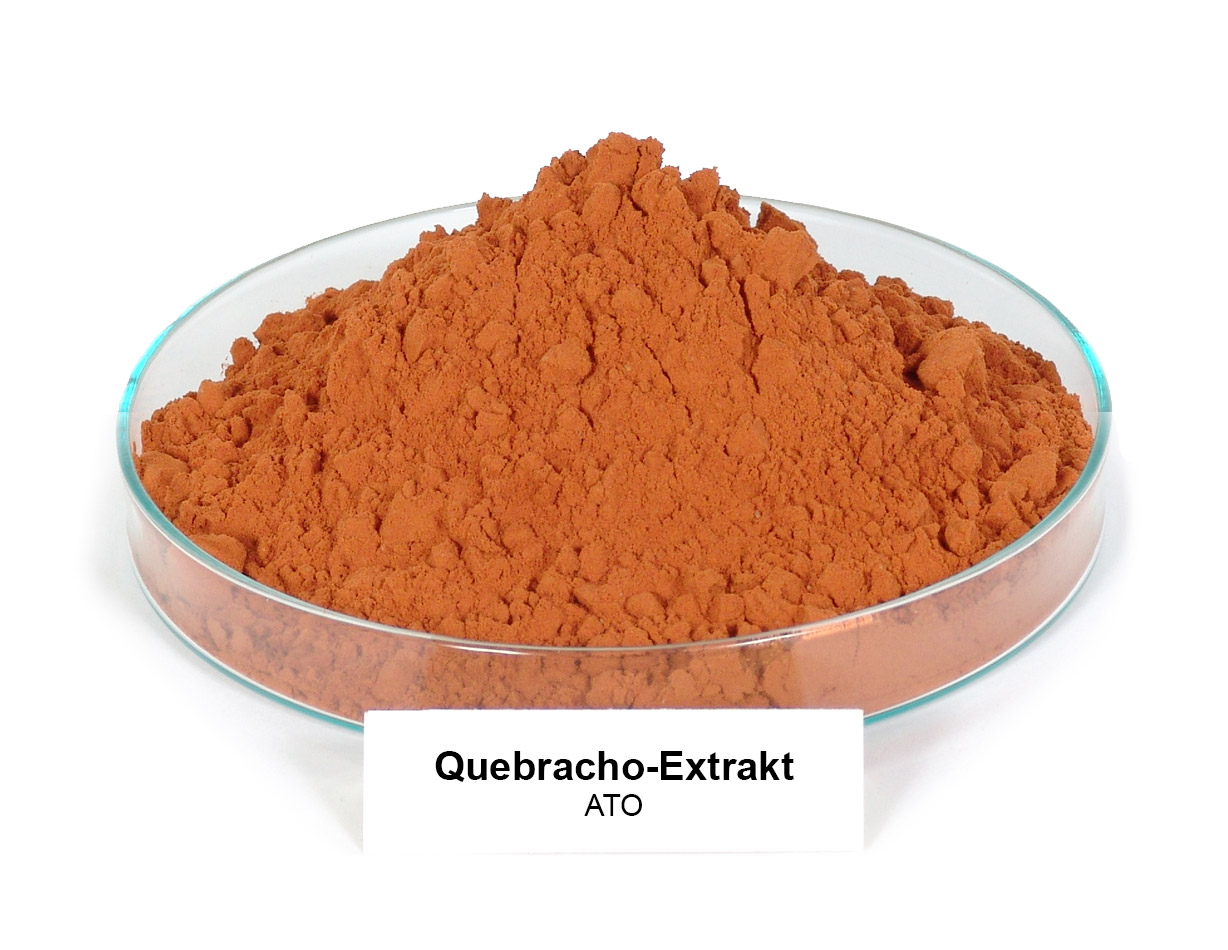
Quebracho extract
Botanical name: Quebrachia lorentzii syn. / Schinopsis balansae
Used for very durable and robust reddish leathers
Colour: Red 5.1% / Yellow 5.9%
Description
The Quebracho extract is won from the inner red core wood of the Quebracho trunk, which grows in South America, mainly in Argentina and Paraguay. The extract of the Quebracho wood belongs to the Catechol group and is assigned to the condensed type of tanning agents. The main characteristics of the cold-soluble extract is a very fast penetration speed into the raw hides, a high content of tanning agents and a rather low content in non tanning agents. Through the rather low acid and medium salt content they are characterized as mild tanning extracts, a feature which can also be taken from the pH-value. The soluble Quebracho extracts can be mixed in each ratio with all other vegetable extracts and Suntans. They can be processed in all stages in traditional methods in pits and drums for the production of all kinds of vegetable leathers and are particularly appropriate for the fast tanning of sole and harness leather, of vachette leather, fine and lining leather. In mixtures with other extracts they can be used for the re-tanning of all kinds of chrome and semi-chrome leathers.
Application
Quebracho tanned leather provides a very durable and robust reddish leather. After tanning the leather is sensitive to light and becomes darker. It is particularly useable for split leather.
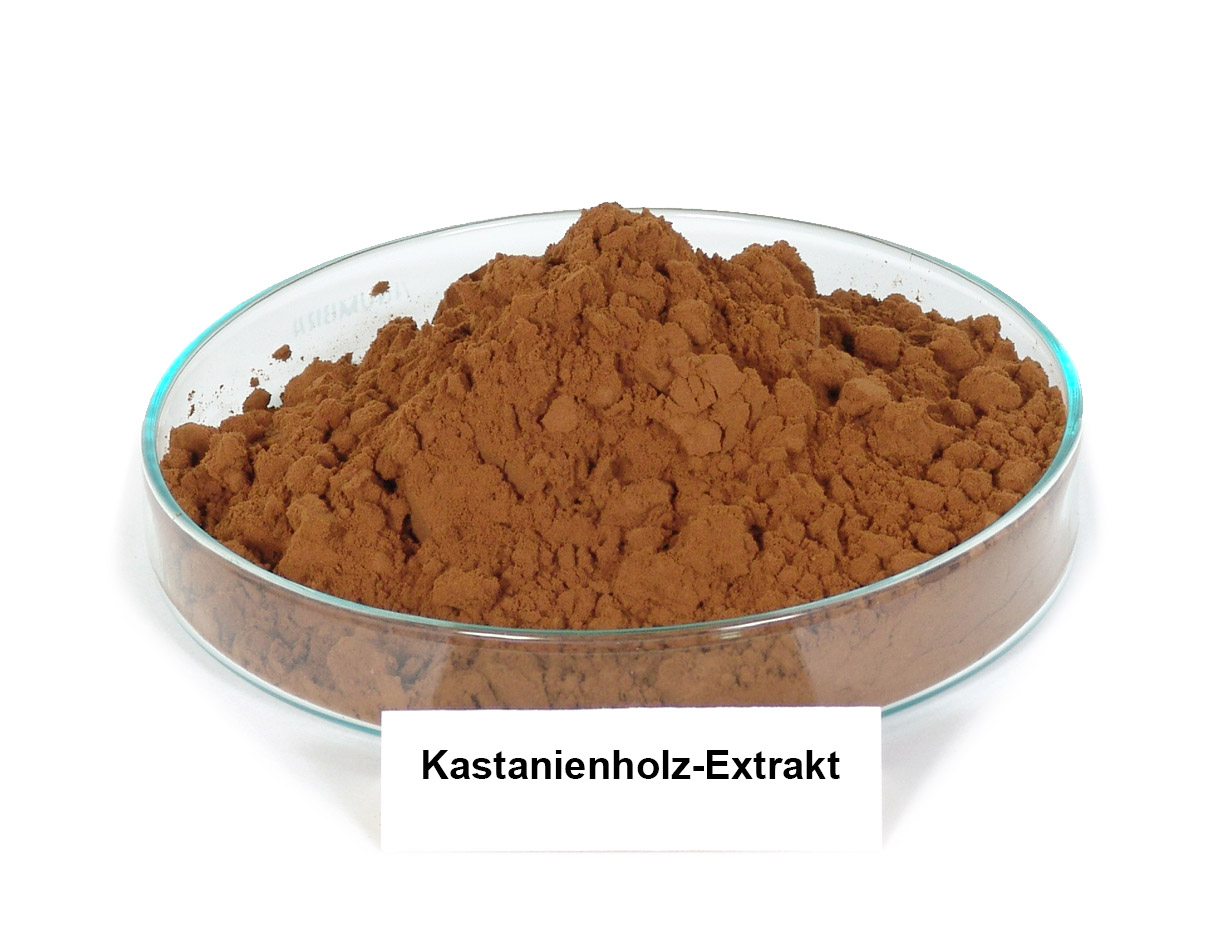
Chestnut extract
Botanical name: Castanea sativa
Used for smooth, compact and full leathers with a good light fastness
Description
Chestnut extract belongs to a group of neutralized sulphite pyrogallol tannins. Chemically it is an ester of phenol carbonic acids and higher alcohol. It is a type of chestnut extract with a reduced astringency and a modified salt/acid ratio. Chestnut extract is used in the re-tanning of leather, tanned with vegetable tanning agents and of chrome leather. The addition amounts up to 30% by weight in all vegetable tanning. For special effects it can be mixed with other agents used in re-tanning. It improves hydrophobic properties of leather, distribution and binding of colour pigments and fats, as well as weight yield.
Application
Use of chestnut extract results in: gross weight yield, excellent physical and chemical properties, even re-tanning and attractive and stable colour. In re-tanning of chrome leather, up to 30% of chestnut extract can be added to obtain smooth, compact and full leather with a good light fastness.
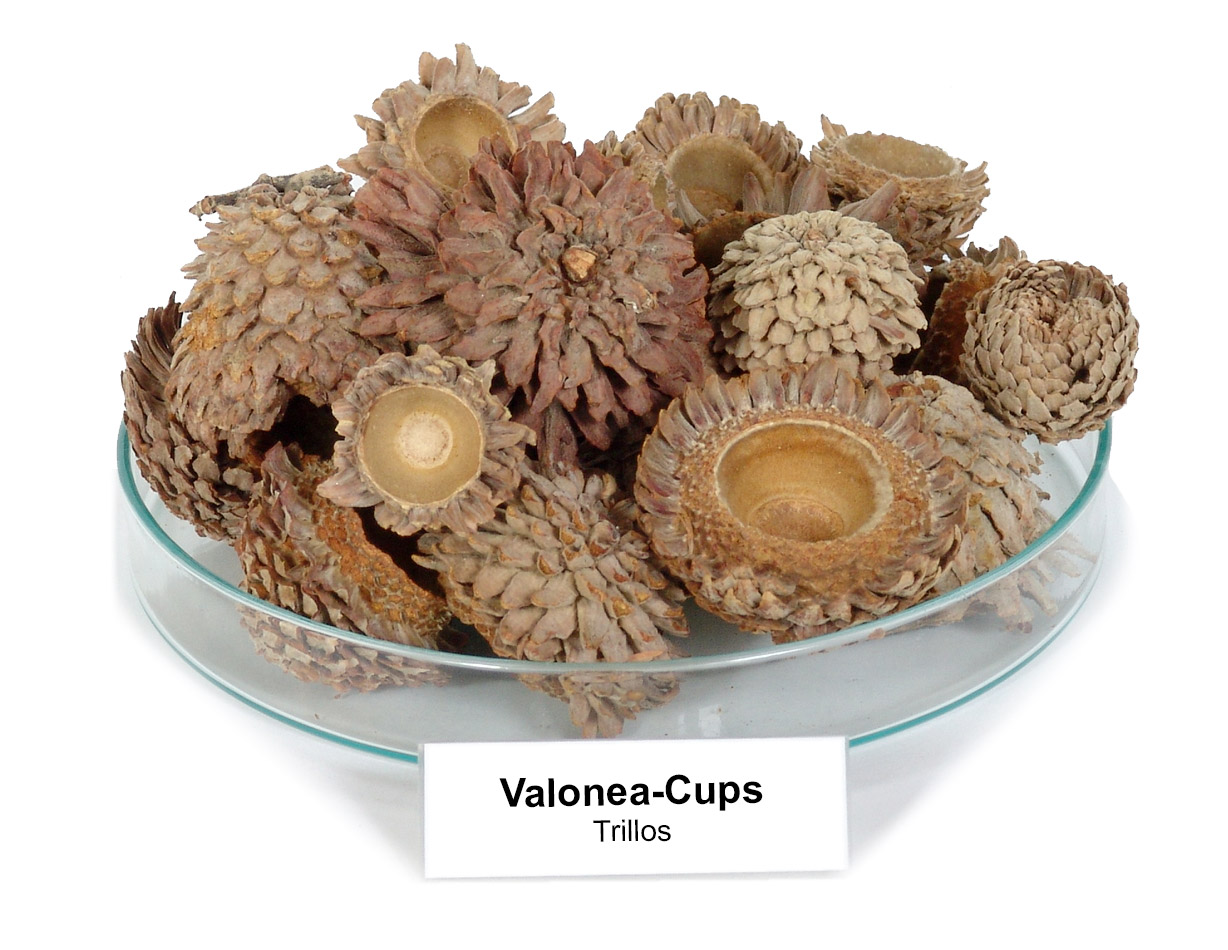
Valonea capsules (Trillo)
Botanical name: Quercus valonea, Quercus macrolepis
Used for soft and flexible leathers as well as firm leathers
Description
The fruit capsules of various types of Mediterranean oak trees (amongst others Quercus valonea) provide the tanning agent. The mature capsules with the scales rich in tannin (known as 'Trillo') are mainly harvested in Turkey and Greece from wild growing trees. After the drying and cleaning the Valonea tanning agents are commercialized in three different versions: as crushed capsules, as Trillo or as tanning extract. The tanning content of the capsules amounts to about 29%, that of the Trillo (scales) about 40% dry matters.
Application
With the help of different tanning methods and the subsequent further processing the leather, it is possible to obtain soft and flexible leathers as well as firm leathers. These leathers can be used for furniture upholstery leather, shoe upper leather, lining leather and for the production of leather goods. Valonea tanned leathers have a light fastness of level 3-4 and outmatch many other vegetable leathers. Also in the production of sole leather Valonea plays an important role.
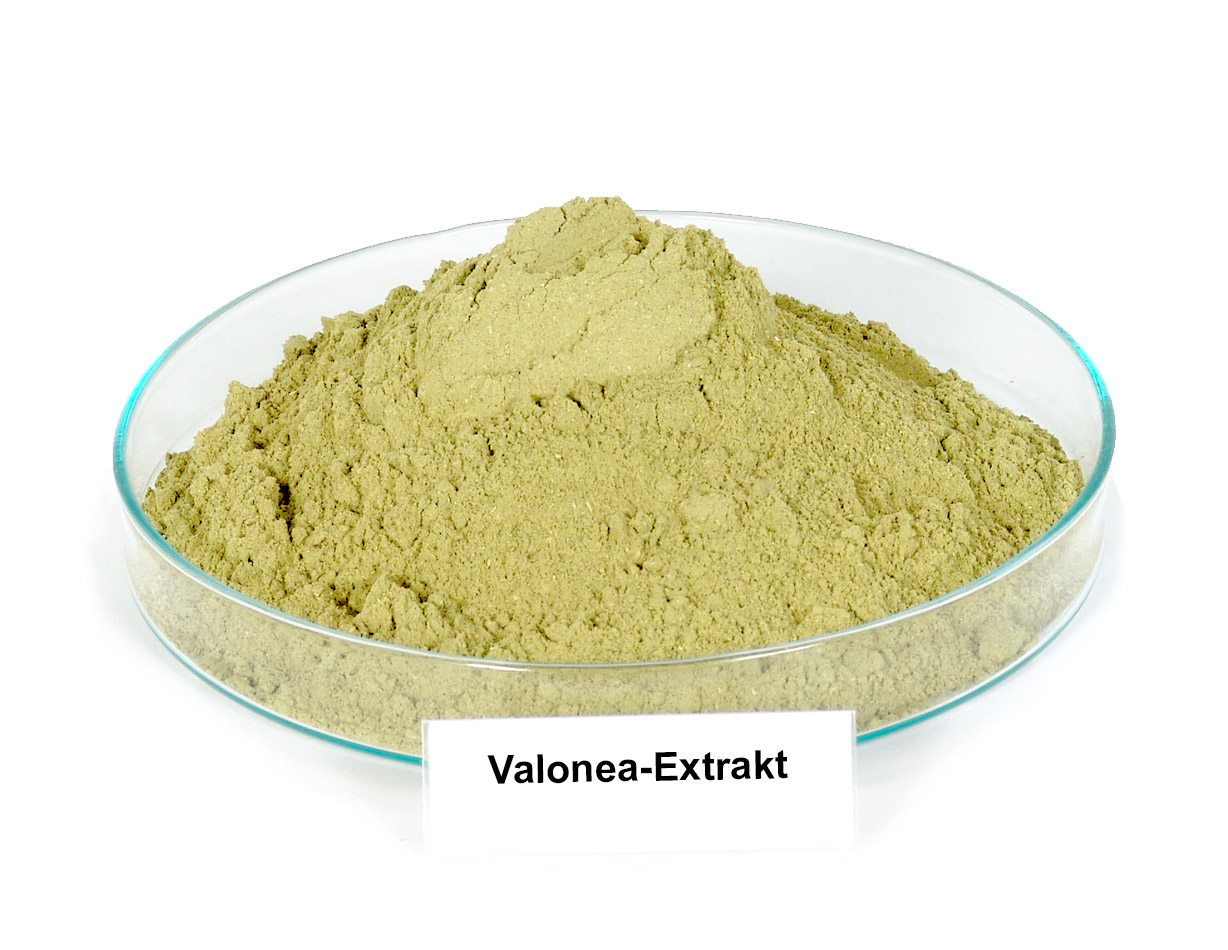
Valonea extract
Botanical name: Quercus valonea, Quercus macrolepis
Used for soft and flexible leathers as well as firm leathers
Description
The fruit capsules of various types of Mediterranean oak trees (amongst others Quercus valonea) provide the tanning agent. The mature capsules with the scales rich in tannin (known as 'Trillo') are mainly harvested in Turkey and Greece from wild growing trees. After the drying and cleaning the Valonea tanning agents are commercialized in three different versions: as crushed capsules, as Trillo or as tanning extract. The tanning content of the capsules amounts to about 29%, that of the Trillo (scales) about 40% dry matters.
Application
With the help of different tanning methods and the subsequent further processing the leather, it is possible to obtain soft and flexible leathers as well as firm leathers. These leathers can be used for furniture upholstery leather, shoe upper leather, lining leather and for the production of leather goods. Valonea tanned leathers have a light fastness of level 3-4 and outmatch many other vegetable leathers. Also in the production of sole leather Valonea plays an important role.
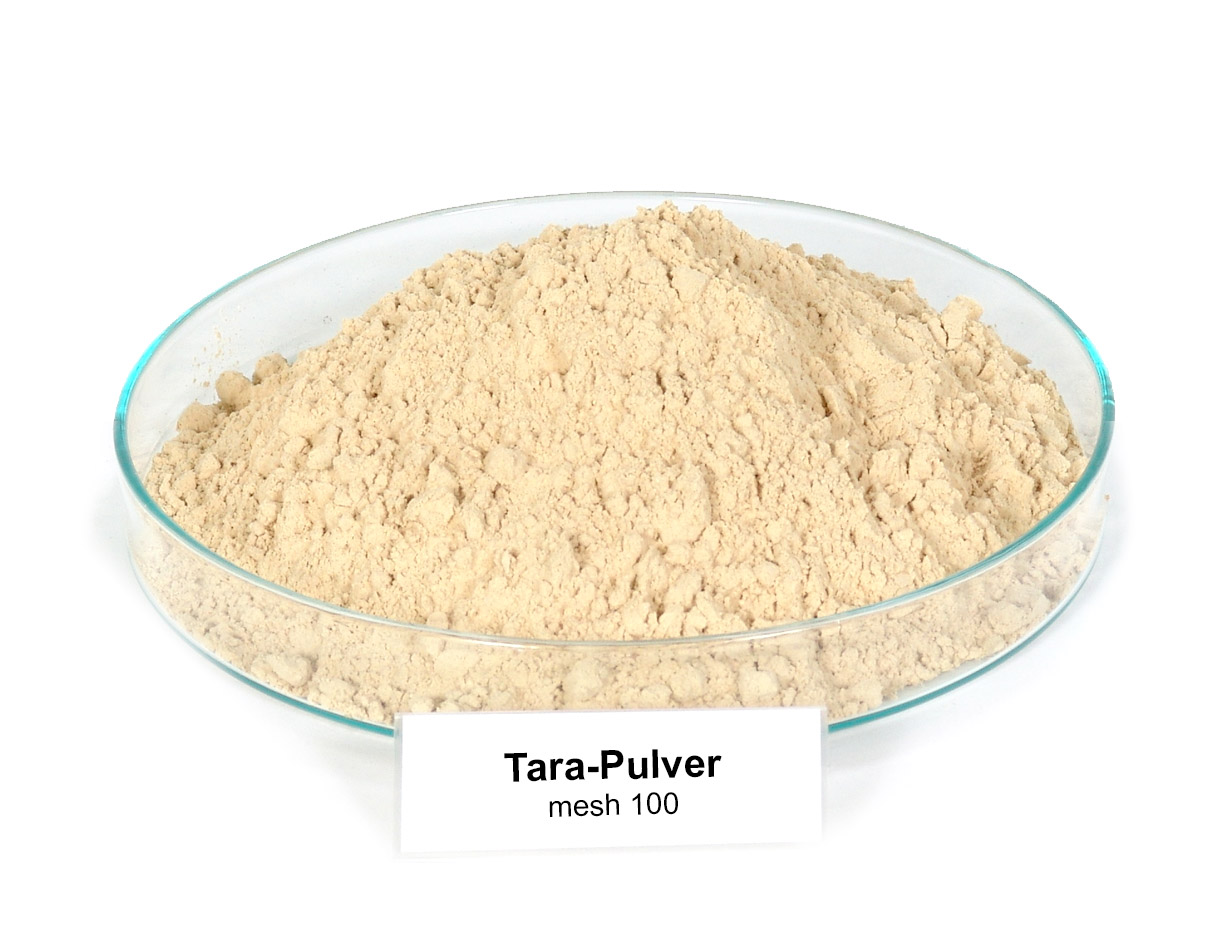
Tara powder
Botanical name: Cesalpina spinosa
Used for easy dyeing, possesses a high light fastness
Degree of grinding: 150 and 200 (200 is finer and has a better penetration)
Description
The Tara tanning agent is extracted from the fruit husks of the small Tara tree (Cesalpina spinosa). The plants grow in Peru in the mild climate of the valleys of the Andes. The plants grow predominantly as wild plants. To a small extent they are cultivated by the native farmers as a protection against erosion or as a natural boundary of their areas under cultivation. In April the Tara husks are harvested. During the harvest the trees are not damaged. The sales of these husks are an important source of income for the rural population in Peru. The precious content of the yellow-red Tara husks were already used centuries ago by the population in Peru as a remedy against sore throat. Various other fields of application of the husks and their content are known: as a basic raw material for the production of colours, as reduction agent in the chemical industry or as decantation agent in the production of alcoholics.
Application
The Tara tanning agent produces cream coloured leather, which is easy to dye and possesses a high light fastness. Tara leathers are available in soft and firm versions. They can be used for car upholstery leather, shoe leather, furniture upholstery leather or leather clothing.
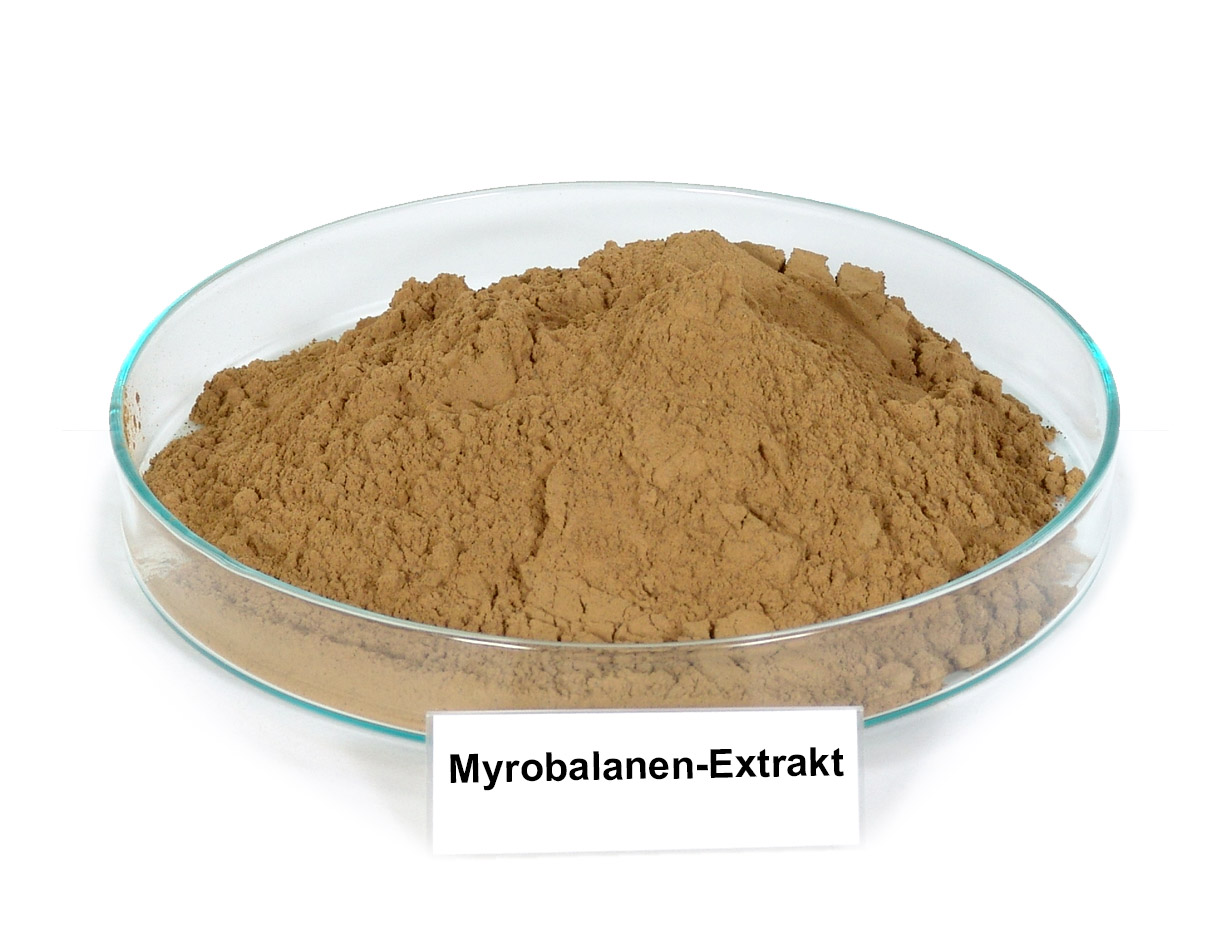
Myrobalan extract
Botanical name: Terminalia-Arten, bes. T. chebula
Used for combination tannages, softer leather
Colour: Red 1.5% / Yellow 3.0%
Description
Terminalia chebula is a tree with a rounded crown and spreading branches. Its principle constituents contain chebulagic, chebulinic acid and corilagin. Its fruits have laxative, stomachic, tonic and alterative properties. It is also known as an adaptogen and hepatoprotective drug. The fruit is astringent, tonic, purgative, carminative, alterative, stomachic, febrifuge, antiasthmatic. It is used in hemorrhoids, ophthalmia, sore throat, dental caries, bleeding and ulcerated gums, and diseases of the spleen. Chebulin isolated from the dried fruits possesses antispasmodic activity resembling that of papaverine. The fruit is antiviral, coagulant and hypoglycemic. The prune-like tannin-containing fruit is also used in tanning and dyeing.
Application
Strongly slugging, Mainly for combination tannages. Gives softer leather.
Sumac extract
Botanical name: Rhus coriaria
Used for soft, flexible und light coloured leathers
Qualities
1. light yellow spray-dried powder made of 'Rhus cotinus'
2. yellow/khaki coloured spray-dried powder made of 'Rhus coriaria' and 'Rhus cotinus'
3. yellow spray-dried powder made of 'Rhus coriaria' and 'Rhus cotinus'
Description
Sumac extract is a tanning agent, which can be manufactured out of a number of different Sumac plants: the most popular are 'Rhus coriaria' - (Tanner's sumac), 'Rhus cotinus' - (Wig Tree), 'Coriaria myrtifolica' - (Tanner's bush) und 'Rhus glabra' - (American sumac, also called white sumac), which all belong to the group of Sumac (Anacardiaceae) plants and which have a high tannin content. One popular Sumac plant in Germany is the Tanner's sumac ('Essigbaum' or staghorn sumac) tree, which is poisonous and does not contain usable tannin. The manufacturing of the extract is done by a macerating process, whereby the dried leaves are pulverized. The powder is manufactured afterwards through a spray drying process. In the Mediterranean area the fruits of the 'Rhus coriaria' are used as a spice.
Application
Sumac tanned leathers are soft, flexible und have a very light colour. Sumac is one of the most noble tanning extracts, but also one of the most expensive ones. This extract is used to manufacture very fine leathers (Morocco or Cordovan leather), which have to be very light and soft. It is also used for the so-called 'sumacizing', which is a type of re-tanning with sumac extract in order to lighten up the leather. A further purpose is the pre-treatment of certain coloured leathers. The sumac tanned leathers distinguish by a special light fastness. Sumac extracts belong to the finest tanning agents and nearly white leather can be obtained with them.
Gambier extract
Botanical name: Uncaria gambir
Used for soft leather, good elasticity
Description
Gambier extract is a tanning agent extracted from the leaves of the Uncaria gambir plant, which comes from Asia and only grows approximately 10° north or south of the equator line. The plant, which grows as a wild bush, can also be cultivated. The Gambier extract is won from the leaves, partly without the branches by extraction with water at a temperature of 85-90°C and evaporation. The powder is then made by the spray-dry method.
Application
By using Gambier extract only, a very soft leather can be obtained, particularly in the re-tanning of calf-leather. However, Gambier extract is also used for the re-tanning of chrome-tanned glove leather, with a remarkable fullness of the leather as well as softness and elasticity.
Oakbark (rasped)
Botanical name: Quercus sessiliflora = Quercus robur
Used for durable and robust yellow-brown leathers with a dark cut
Description
Oak bark contains 6-17% of tannins. The tannin content depends on the age of the bark and the harvesting time. The tannins have an astringent effect. This effect is utilized in the application of oak bark for baths, poultices and mouth paints. These mouth paints are used to ease inflammations of the gums and the mouth mucous membranes. Also diseases of the skin and the mucous membranes connected with strong itching can be treated by oak bark baths. The ancient Germans used oak leaves by storing them during the winter in order to tan the pelts of sacrificial animals. The oak bark, which is richer in tanning agents, is used until nowadays as an important raw material for the preparation of tanning liquids.
Application
Leather tanned with oak bark with the tan-pit tanning system provides very durable and robust yellow-brown leather with a dark cut, which is used until today especially for sole leather in the higher price segment and for health shoes. Due to the long production time of this leather the production costs are quite high.
